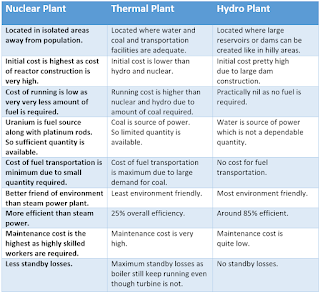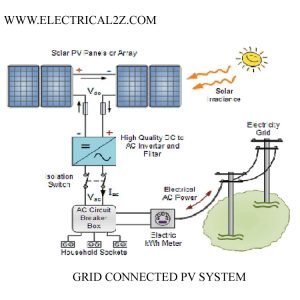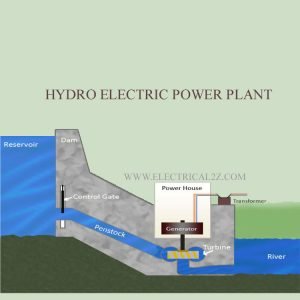A nuclear power plant, heat energy is generated by a nuclear reaction called as nuclear fission. Nuclear fission of heavy elements such as Uranium or Thorium is carried out in a special apparatus called as a nuclear reactor.
A huge amount of heat energy is generated due to nuclear fission. Due to fission, a huge amount of heat energy is produced which is transferred to the reactor coolant. The coolant system may be water, gas or a liquid metal.
The heated coolant is made to flow through a heat exchanger where water is converted into high temperature steam. The generated steam is then allowed to drive a steam turbine. The steam, after doing its work, is converted back into the water and recycled to the heat exchanger. The steam turbine is coupled to an alternator which generates electricity. The generated electrical voltage is then stepped up using a transformer for the purpose of long distance transmission.
Table of Contents
Important Components of a Nuclear Power Plant
- Nuclear reactor
- Fuel
- Moderators
- Control rods
- Heat exchanger
- Steam turbine
- Alternator
- Condenser
- Shielding
- Coolant
- Turbines
- Generator
Nuclear Reactor
It is a special apparatus used to perform nuclear fission. Since the nuclear fission is radioactive, the reactor is covered by a protective shield. Splitting up of nuclei of heavy atoms is called as nuclear fission, during which high amount of energy is released.
Nuclear fission is done by bombarding slow moving neutrons on the nuclei of heavy element. As the nuclei break up, it releases energy as well as more neutrons which further cause fission of neighboring atoms. Hence, it is a chain reaction and it must be controlled, otherwise it may result in explosion. A nuclear reactor consists of moderator, fuel rods, and control rods.
Types of Nuclear Reactors
There are two types of nuclear reactors used in the nuclear power plant. They are
- Pressurized Water Reactor
- Boiling Water Reactor
1. Pressurized Water Nuclear Reactor
Pressurized water reactor uses regular water as coolant. The coolant is kept at very high pressure so that it does not boil. The heat exchanger transferred the heated water where water from secondary coolant loop is converted into steam. Thus the secondary loop is completely free from radioactive stuff.
In a pressurized water reactor, the coolant water itself acts as a moderator. Due to these advantages, the type of reactors are most commonly used.
2. Boiling Water Nuclear Reactor
In the boiling water reactor only one coolant loop is present. The water is allowed to boil in the reactor. The steam is generated as it heads out of the boiling water reactor and then flows through the steam turbine. One major disadvantage of a boiling water reactor is that, the coolant water comes in direct contact with fuel rods as well as the water turbine. So, there is a possibility that radioactive material could be placed on the water turbine.
Fuel
In the reactor, we use the fissionable that is called a fuel. The commonly used fuels are Uranium, Plutonium or Thorium. It can be Uranium-238, Uranium-235, Plutonium -236 or Thorium -232. Uranium is mostly preferred. Because, it has high melting point.
Moderators
Only neutrons of a fairly low speed should be used to control chain reaction. Moderators are used to slow down the speed fast moving neutrons produced during the fission process. Moderator reduces
the speed of the neutron by absorbing its energy but it will not absorb neutron.
Control Rods
The control rods absorb neutrons and stop the chain reaction to proceed further. Control rods are made up of steel containing a high percentage of material like cadmium or boron. Because of they can only absorb the neutrons. When control rods are properly inserted into the moderator side then all the neutrons is absorbed and reaction comes to halt.
Heat Exchanger
In the heat exchanger, the primary coolant transfers heat to the secondary coolant . Thus water from the secondary coolant is converted into steam. The primary system and secondary system are never allowed to mix up with each other because they are closed loop. Thus, heat exchanger helps in keeping secondary system free from radioactive stuff. In boiling water reactors there is no need for heat exchanger.
Steam Turbine
Generated steam is passed through a turbine, which runs due to pressure of the steam. As the steam is passed through the steam turbine blades, the pressure of steam gradually decreases and it expands in volume. The steam turbine is coupled to an alternator.
Alternator
The turbine rotates the shaft of an alternator thus generating electrical energy. Electrical output of the alternator is transferred to a step up transformer to transformation.
Condenser
The steam coming out of the steam turbine, is then converted back into water in a condenser. The steam is cooled by cold water loop.
Shielding
It prevents radiations to reach outside the reactor. Lead blocks and concrete enclosure that is strong enough of several meters thickness are used for shielding.
Coolant
It is substance in a pipe to the generator where water is boiled. In this heat exchange process occurs. The coolant is absorbed the heat which is produced in the reactor. The types of coolants are water, carbon dioxide gas or liquid sodium.
Turbines
Steam produced in the boiler is now passes to a turbine. The force of the steam jet causes the turbine to rotate. Heat energy is converted to mechanical energy.
Generator
It consists of coils that change the mechanical energy into electric energy. The turbine moves and the change in magnetic flux cause electricity. Generator is transmitted to substations for distribution of electric power.
 |
| Nuclear Power Plant vs Other Plants |
Advantages of Nuclear Power Plant
- This is environmentally clean – small amount of greenhouse gas emission.
- High amount of electrical energy is generates for the footprint of the power plant.
- Materials are already exist to build them.
- Generates less waste than other plants.
- Does not use fossil fuel.
- Nuclear power is highly reliable.
Disadvantages of Nuclear Power Plant
- Generates nuclear waste cannot be dispose of yet only can store away.
- The consequences of an accident are high.
- Relies on uranium as a fuel, which is limited in quantities and non renewable.
- Requires extensive planning and development, so very slow to build.
- Expensive to build and maintain.
- The plant is not environmentally friendly.
Comparison of Nuclear Power Plant with Thermal and Hydro Power Plant
| Nuclear Power Plant | Thermal Plant | Hydro Plant |
| Located in isolated areas away from population. | Located where water and coal and transportation facilities are adequate. | Located where large reservoirs or dams can be created like in hilly areas. |
| Initial cost is highest as cost of reactor construction is very high. | Initial cost is lower than hydro and nuclear power plant. | Initial cost pretty high due to large dam construction. |
| Cost of running is low as very very less amount of fuel is required. | Running cost is higher than nuclear and hydro due to amount of coal required. | Practically nil as no fuel is required. |
| Uranium is fuel source along with platinum rods. So sufficient quantity is available. | Coal is source of power. So limited quantity is available. | Water is source of power which is not a dependable quantity. |
| Cost of fuel transportation is minimum due to small quantity required. | Cost of fuel transportation is maximum due to large demand for coal. | No cost for fuel transportation. |
| Better friend of environment than steam power plant. | Least environment friendly. | Most environment friendly. |
| More efficient than steam power. | 25% overall efficiency. | Around 85% efficient. |
| Maintenance cost is the highest as highly skilled workers are required. | Maintenance cost is very high. | Maintenance cost is quite low. |
| Less standby losses. | Maximum standby losses as boiler still keep running even though turbine is not. | No standby lo |
Hope you understand this article about the Nuclear Power Plant. In case of any doubt please comment below. Please follow our website for future updates. Thank you for visiting our website @ElectricianWorld.Net.




Nuclear power plant disadvantages are need to be mentioned clearly update it bro…